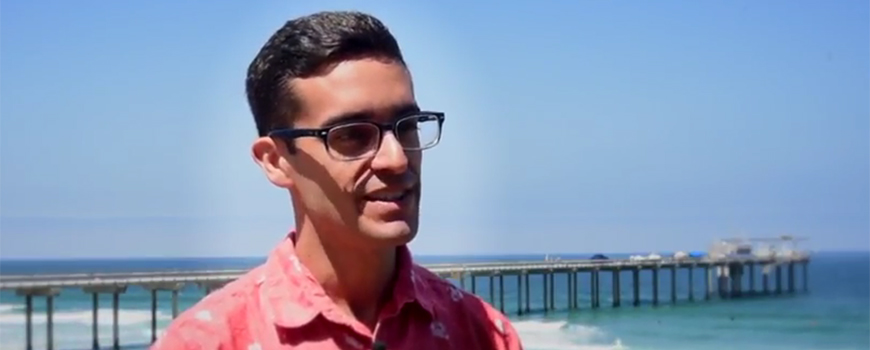Global S&T Development Trend Analysis Platform of Resources and Environment
| A Scientist’s Life: Andy Nosal | |
| admin | |
| 2017-08-02 | |
| 发布年 | 2017 |
| 语种 | 英语 |
| 国家 | 美国 |
| 领域 | 资源环境 |
| 正文(英文) |  Marine biologist Andy Nosal
Andy Nosal is a marine biologist who received his PhD degree from Scripps Institution of Oceanography at the University of California San Diego in 2013. He continued his research as a postdoctoral research fellow at the Birch Aquarium at Scripps from 2013 to 2016. Currently he is a teaching professor in the Department of Environmental and Ocean Sciences at the University of San Diego and holds a concurrent visiting assistant researcher appointment at Scripps. Nosal studies the behavior and ecology of sharks and rays in Southern California and Baja California with a special focus on the species common in La Jolla, including leopard, soupfin, and sevengill sharks, bat rays and shovelnose guitarfish. en: What do you do for a living? AN: I am a marine biologist with a specialty is shark biology. I am interested in the behavior, ecology and conservation of sharks and their relatives, the rays. Another passion of mine is science communication. I believe as a scientist, an important part of my job is getting out and engaging with the public. en: What tools do you use for your research? AN: Most of my research happens in the field, so I spend a lot of my time on small boats in the hot sun trying to fish for sharks. My fellow researchers and I place tracking devices on the animals so we can understand their movement patterns and why they do what they do. One kind of tracking device I use is an acoustic pinger tag. These are about the size of a AA battery and emit a pinging sound underwater. I can externally attach or surgically implant a pinger tag into a shark, allowing me to follow the sounds over days or years to learn where these animals go. Another kind of tracking device is a pop-up satellite archival (PSAT) tag. These are externally attached to a shark and record depth, temperature, and light levels for up to 12 months. At a pre-programmed time, the PSAT tag releases from the shark and floats ("pops up") to the surface, where it transmits the stored data to a satellite. Later, using those data, I can reconstruct the location and depth where the shark has been. Lastly, I can track sharks by direct observation. As an example, every year hundreds of leopard sharks aggregate in the shallow waters just outside the surf of La Jolla Bay. Their dark bodies contrast beautifully against the lighter sand below, making aerial video tracking a great research tool. I capture aerial video of the leopard sharks using a drone or tethered helium balloon and then digitally track all the sharks in the field of view, frame-by-frame, to determine whether they are attracted to and interacting with each other (evidence of social behavior) or simply all attracted to the favorable habitat at that location. en: What are the big questions in your field? AN: Sharks are still one of the most understudied animals on the planet. The biggest question in my field is why do sharks do what they do. It is one challenge to track the movements of wild sharks and determine where they have been, but it is quite another to understand what are the underlying mechanisms driving that behavior. I am trying to figure out why those movements occur and how they benefit the animals. This requires an interdisciplinary approach to relate shark movement patterns to aspects of physical and chemical oceanography, geology, and atmospheric science, among other fields. Complicating matters is that sharks exhibit "personalities" and often show great variation in their behavior that cannot be explained. en: Why did you pick Scripps as a place to work? AN: Scripps is an amazing place to do shark research because we have access to many shark species right in our backyard. For example, my field site in La Jolla—a shark and ray hotspot—is less than a mile away. From the time I launch a research skiff from Scripps Pier, I can be doing field work in 10 minutes. Scripps is truly a special place to work, which is why after receiving my PhD degree here, I stayed on as a postdoctoral research fellow with the Birch Aquarium, and am still here today conducting my research. – Annie Reisewitz This story appears in explorations now, Scripps Institution of Oceanography's award-winning ocean and earth science magazine. Sign up to receive our free monthly story roundup.
|
| URL | 查看原文 |
| 来源平台 | Scripps Institution of Oceanography |
| 文献类型 | 新闻 |
| 条目标识符 | http://119.78.100.173/C666/handle/2XK7JSWQ/107552 |
| 专题 | 资源环境科学 |
| 推荐引用方式 GB/T 7714 | admin. A Scientist’s Life: Andy Nosal. 2017. |
| 条目包含的文件 | 条目无相关文件。 | |||||
| 个性服务 |
| 推荐该条目 |
| 保存到收藏夹 |
| 查看访问统计 |
| 导出为Endnote文件 |
| 谷歌学术 |
| 谷歌学术中相似的文章 |
| [admin]的文章 |
| 百度学术 |
| 百度学术中相似的文章 |
| [admin]的文章 |
| 必应学术 |
| 必应学术中相似的文章 |
| [admin]的文章 |
| 相关权益政策 |
| 暂无数据 |
| 收藏/分享 |
除非特别说明,本系统中所有内容都受版权保护,并保留所有权利。
修改评论